Towards the end of WWII, in 1944, the Japanese Navy developed a copy of the American M1 Garand rifle, chambered for the 7.7mm cartridge. This followed attempts to simply rebarrel captured US guns, which did not work well because of difficulty getting the en bloc clips to function properly. The newly manufactured Japanese rifles were equipped with a 10-round magazine fed by standard 5-round stripper clips in order to sidestep this problem. The guns were manufactured at the Yokosuka Naval Arsenal, and only about 125 were completed when the war ended (although parts for 200 were made).
I had an opportunity to handle one of these, and took a selection of photos. I was not able to disassemble the gun, so I don’t have any internal pictures – but the exterior views will hopefully be useful:




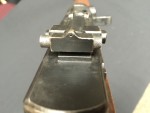
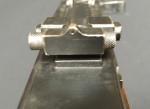

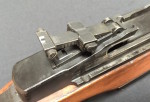
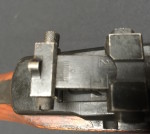








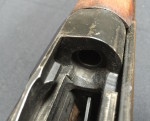

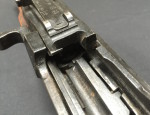
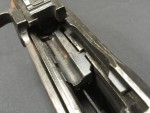
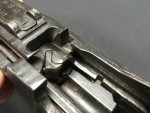
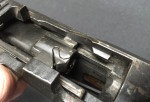
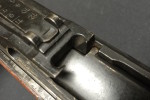
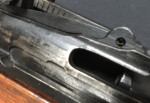

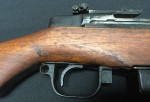




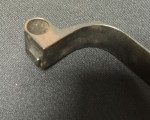
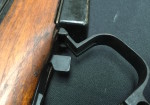
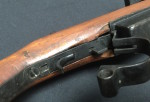
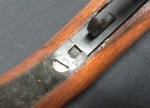






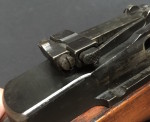
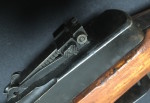
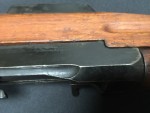
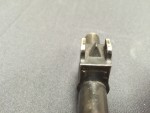


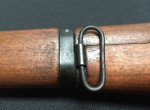


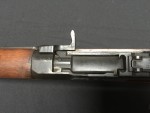





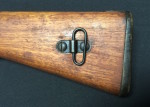
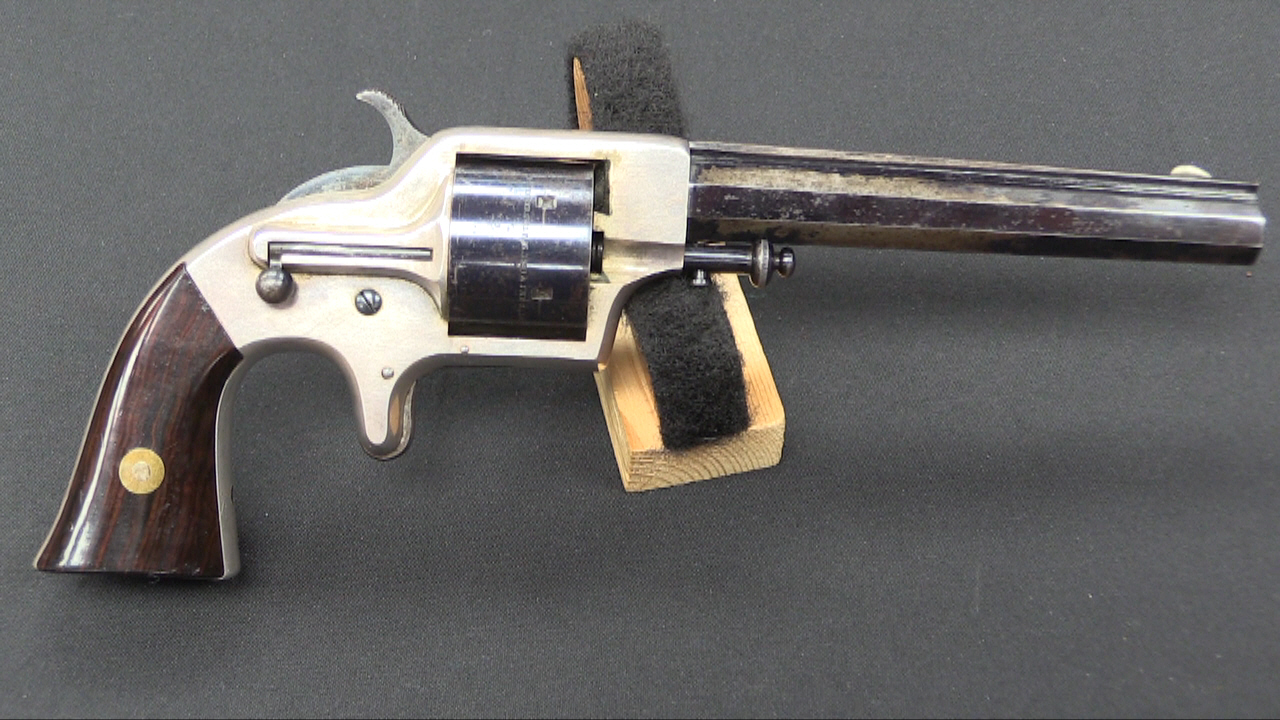
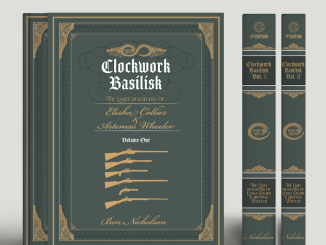
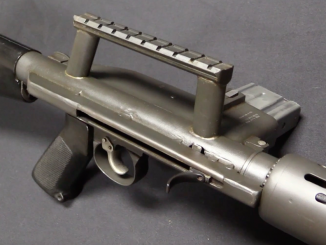
I question whether the en bloc clip was the problem.
7.7 x 58mm Arisaka and 7.62 x 63mm (.30-06) U.S. Springfield have virtually identical rim and head diameters, rim thickness, and case taper, and only 5mm difference between case lengths and 6mm to 7mm difference in OAL with most bullets.
It should have been no more problem than 7.62 x 51mm NATO in a modified Garand with a “bushed” chamber, in terms of feeding. In fact,less, because .30-06 and .308 Winchester are nearly half-an-inch (12mm) “off” in relative OAL.
More likely, the problem was propellant powder. My SWAG is that the burning/pressure curve of the Arisaka rounds was enough different from U.S. issue .30-06 standard to throw off the operating cycle of the Garand gas system.
Or else the maximum pressure just wasn’t sufficient for the mechanism. The 7.7mm Nambu Type 99 LMG had those sorts of problems on top of poor primary extraction, hence the need for the cartridge oiler.
Gas-operated arms tend to be persnickety about that sort of thing.
cheers
eon
Purest speculation on my part, but the problem with the M1 clips may have been as simple as just not having any. Or at least enough to make the effort worthwhile. In my experience a captured weapon tends to go back to the staff types with just one magazine, or at times none. It’s not hard to imagine the Japanese holding one hundred M1s but only 85 or so clips for them. And the M1 without a clip is a single shot bolt action. Just a thought.
Sua Sponte.
Why go through the trouble of building all the stamping equipment for making the enbloc clip when you can just use a standard fixed magazine and all the existing 5 round Arisaka clips?
Eon, the Type 99 LMG does not have a cartridge oiler. You are thinking of the Type 96. Otherwise, I agree that formulation of powder might have been part of it.
“Gas-operated arms tend to be persnickety about that sort of thing”
So far I know, most of Soviet gas-operated weapons have adjustable gas system.
I agree with Fleetwood. The Japanese wouldn’t want to complicate their insane logistical troubles further by developing a rifle clip incompatible with the standard bolt-action rifles. The Type 38 and Type 99 Rifles could be loaded without their stripper clips, but a Carcano would be screwed without en-bloc clips. And remember, clips were regarded as disposable in those days…
“Way back when…” we often re-chambered the Model 99 Arisaka by re-reaming with a .30-06 chamber reamer making them into a 7.7-06. I still have a lot of cut-down ’06 brass converted to 7.7 back before Norma started making “7.7 Jap” virgin brass casings. The secret to long life of these ’06 to 7.7 conversions was to NEVER use this converted/cut-down brass in but one rifle; the base diameter is smaller in the ’06 than the original 7.7 brass and it will slightly bulge just ahead of the extraction groove when first fired.If you full-length resize them they will split so you only neck-size them. As for the conversion, noted in the M-1 clones, I agree that the problem was probably propellant pressure curve variations. I have loaded and shot thousands of ’06 ammo through an M-1 and they can be “persnickety” if the appropriate powder not is used. The best I found as the old H-4831 which was originally reclaimed military. The later newly-manufactured Hodgen 4831 was not as reliable and I believe the major difference in the two was in the grain coatings and not the basic propellant formulations. I would like to have one of these to playwith to see if this might be the problem.
I wonder if you meant 4895 as 4831 would be very wrong for reloading M1 Cal 30 Cal Rifle cartridges. H4895, IMR 4895 and IMR 4064 should be the powders used for 30 Cal Rifle cartridges unless a ported gas plug is used on an M1 30 Cal Rifle.
Data from: Альбом конструкций патронов стрелкового оружия
USA CARTRIDGES:
7,62-MM RIFLE CARTRIDGE
POWDER:
Pyroxylin
GRAIN:
tube, outer diameter 0,82, inner diameter 0,15, length 2,07
(all dimensions in mm)
As I said, “The best I found as the old H-4831 which was originally reclaimed military.” During the war (WWII) you could not even buy black powder because it was needed for the war effort. The “H-4831” I mentioned in my post was “reclaimed” in that you could not buy any form of smokeless until later after the war was over. You could get a 55-gallon steel drum full of loose M-1 ammo, or often .50 cal ammo, for about $50.00 at most. You could set up in your garage and then pull the bullets and dump the powder and then sell whatever you had to people who had not had powder in 5-10 years. You sold it to the public in paper sacks, glass canning jars, or whatever would keep it dry. I was born in March of 1939 so I was 6 when the war ended but this continued until I was about 15 when I started reloading myself. Needless to say, the quality was not “consistent” by any means. Most of what was sold as 4831 at that time was the slower burning powder. I remember going from East Texas to Barksdale Air Force Base in Bossier City, Louisiana with a friend and his father to pick up the loose rounds in barrels. They were auctioned off at that time as “surplus materials” to the highest bidder. a LOT of this was salvaged from M-1 ammo and worked just fine but I have seen powder that had 2-4 different grain sizes in the same quart jar full meaning that it probably a mixture of M-1, .50 cal and 20mm and God only knew what else powders mixed together. Later we were able to buy several different formulations of powders for different applications. However, my favorite remained 4813 because I always believed that the case needed to be completely full up to the base of the bullet in order to achieve consistent ignition. Even to this day I load my 7.7 Japs, .243s, .308s, 6mm Rem and other like rounds with 4831 in this manner. It drives most people crazy seeing me measure the charges with a teaspoon and funnel while I have all this technical reloading equipment on the bench. I have made 103 consecutive one-shot kills on deer and over 200 on wild hogs with these rounds at ranges from 25 yards out to over 300 yards. I also re-qualified on the sniper course with my 7.7mm Arisaka Sniper in 1964 at Camp Shelby in Mississippi with a score of 448/450 (500 yard max range) using this ammo which was as good as my score with my .300 Win Mag Rem M-40 with rounds reloaded at the Quantico shop. The difference in then and before was that at this time I was using modern manufactured propellant instead of that reclaimed as above AND I was using Rem Mag Large Rifle Primers. You can’t argue with success.
55 gal oil drums filled with loose 30-06 ball for $50.00. I wish that stuff was still available it would be heaven. How many rounds could fit in a 55 gal drum?
Back at that time $32 bought an ounce of gold (or it did if you were a central bank – ordinary peons could neither redeem paper nor own gold)
Current price of gold is around $1,200 / ounce
Assuming that gold were $1,200/ oz and assuming that the gold price provides a suitable proxy for more general price inflation
Then the barrel of .30-06 would be $2,062.50 in todays dollars
Still looks like a good deal to me!
“Still looks like a good deal to me!” It was except that my father was making about 38-39¢ per hour at the time. I worked at a Humble Oil service station in the mid-1950s for 50¢ per hour fixing flats on oilfield 18-wheelers … but gasoline was 15.5¢ per gallon then. As for people having surplus stocks of powder, I still have “ration stamps” from that period for one pound of butter per family per month, 3 pounds of sugar, etc. Forget tires and tubes unless you were working at a “critical level job” which Dad’s was in the oilfield. Even if you had several hundred dollars you could not buy a new tire without the appropriate paperwork. If you had more than you were allowed you were arrested for “Hoarding” and served time. We did okay because Mom and Dad were great gardeners and at raising chickens and rabbits on grass they cut and such. Everyone had a pig or two that was raised on wastes called “slop” and anything else you could get. You hunted and fished for food and not fun. Grown men became exp[ert with a sling-shot made with strips cut from an old truck “intertube” (“tire tube” to you young folks). Dad also raised bees for honey and bees wax. It was in interesting time. I was too young to remember it all but I do remember a lot of it.
Bill,
From what you’ve said, you are about the same age as my father. Clearly I don’t remember those times, but I have heard stories.
In Britain, post war rationing of food stuffs was reintroduced and continued until 1952 – largely because all money was going to repay war loans. Britain held the world record for the highest tax rates, and France was in second place. only minimal ammounts of money were allowed to go towards food imports.
Fuel and tyres were only allowed for essential workers. Tractors were usually supplied on “spade lugs” (steel wheels with big steel or cast cleats)
Everyone kept a pig, and as most people in this area had neither mains electric nor refrigerators, the results of pig killings got shared with friends and neighbours, who shared theirs in turn, assuring a regular supply of fresh pork goodies.
Rabbit meat not rationed, and my grandfather was very good at catching wild ones with a long net.
The gentleman who lived next door when I was a child had been reported for selling butter and eggs on the black market during rationing, a very serious criminal offence. He appeared in front of the local magistrates, and I think he got off entirely, or a nominal fine at worst – they were his best customers!
There were rumors that a more distant neighbour had had a tractor with its rear tyre full of five pound notes until the 1960s – he didn’t dare to begin to spend them until then. His farm was later opencast for coal, and the guys stripping the soils found lots of pits with sheep skins in them, mysteriously the flesh bones and horns had all completely decayed away just leaving the skins… very strange soil conditions.
the presence of the pits was explained by the losses during the snowstorms of 1947.
A fat lamb, even through the official market, raised the equivalent of 2 weeks pay for the farm worker – now it is barely half a day’s pay.
I still call a tire tube a inter tube/ innertube so I understand what you mean. By the way could you put some of that surplus propellant in a “poke” for me. ( “poke” Appalachian slang for a paper bag.) How’s that for odd ball terminology?
While I only have what was written during WW2, I’d have to disagree about powder not being available to the public during entire WW2 period. While distributors weren’t getting new supplies, they had it in stock. Primers were a different matter.
I have a digital copy of a book written late in WW2 by two guys from Iowa(I think) by the names of Albert and Olberg. It is mainly about making primer compounds, both corrosive and non-corrosive. It states that powder was available during the war from the distributors, but it was in short supply. So they did go a bit into a couple of DIY non-nitrocellulose smokeless powders.
FWIW. They did do a good job with their testing, as they even had pressure and velocity testing done. That wasn’t a cheap local nor DIY back then.
Can you give me any information on the book by Albert and Olberg? I cannot find any listing or reference. Any ides where I can find a copy, digital or paper?
The title is “Primers for Small Arms Cartridges”. I see the names are Albert and Oelberg.
I got the digital copy from a guy that goes by Dutchman on the Cast Boolits forum. The mixes in this book aren’t perfectly balanced, but do work. I was able to get them to work better with the assistance of the software used for formulating rocket fuels.
If you are interested in such things, there is a long thread on that forum about making primer compounds. It includes a couple of what one could consider state of the art ones.
Hope this helps.
I have one of these Type 4 rifles. It is the only documented Type 4 in existence. I bought it indirectly from the intelligence officer who removed from the factory, loaned it to the Marine Corps museum for many years, asked for it to be returned to him, and then he sold it. I have all of the paperwork documenting the above including an affidavit from the officer who took the rifle, and two others, from the arsenal. His commanding officer took one and the FBI took the other. It was this man’s job to retrieve weapons, as an intelligence officer, for return to the US, and to complement the FBI library of weapons.
The cover letter from Quantico confirms the above and thanks the officer for loaning the museum the rifle. The Quantico stock number is still on the trigger guard.
The Infantry museum at the School of Infantry in Singleton NSW, Australia has a M1 chambered for 303 British. AS a young digger on IETs I remember seeing it displayed and it caught my eye.
Why? can never get any information on it on the web, but I suspect in preparation of Operation Downfall and the US mandated requirement to standardise equipment, the Australian engineers may have experimented with re-chambering the M1 with a view to adopting it for the invasion of Japan.
Please, if you do come to Australia for any reason, contact the both the Lithgow Small Arms museum and the School of Infantry Museum and inspect and report on the firearms on display. Australia has a forgotten firearms and R&D industry dating back to prior to WW2 (earlier if you include the opening of the SAF prior to WW1)